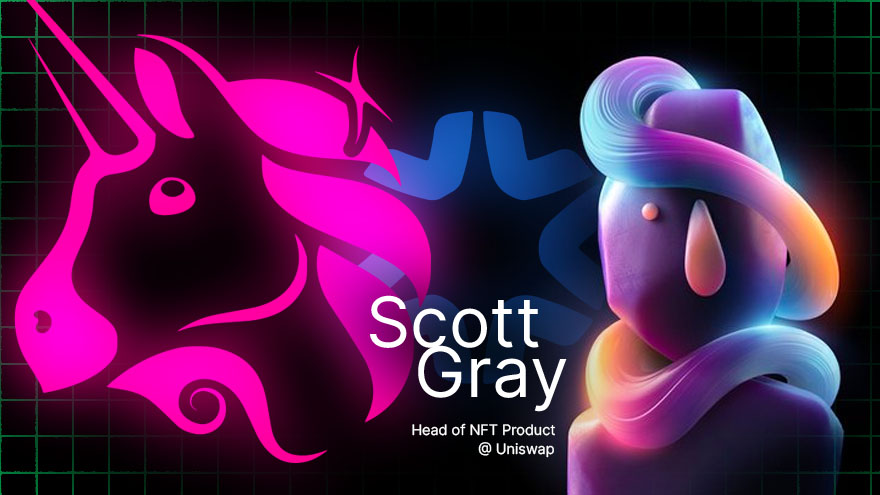© Defiant Media Inc 2022
Advertisement
New Aggregator Won’t Compete With Sudoswap On AMM Pools, Plans To Integrate Blur
By: Aleksandar Gilbert
When Uniswap debuted its new, NFT marketplace aggregator on Wednesday, it also shuttered Genie, the NFT marketplace aggregator it had acquired in June.
“The genie went back in the lamp,” Scott Gray, Genie founder-turned-Uniswap NFT chief, quipped.
But Uniswap’s NFT marketplace isn’t just Genie with new, magenta branding, Gray insists. In an interview with The Defiant, Gray touched on the difference between the two aggregators, Genie’s acquisition by Uniswap, the NFT royalty debate and why certain marketplaces aren’t featured in the new platform.
This summer, Gray approached Uniswap Labs’ newly established venture fund seeking an investment that would help the company scale, he said. Teo Leibowitz, the head of Uniswap Labs Ventures, countered with an acquisition.
“I didn’t really think much about that just because we were pretty set on raising money,” he said. “And then we had a call with Hayden [Adams, Uniswap founder], and I think that’s when everything clicked.”
Adams pitched a vision in which they created a platform that would serve as “the marketplace for all digital assets,” Gray said.
In an appearance on Rug Radio Wednesday, Adams said the move would bring two relatively siloed communities under one roof.
Only 20% of people who have bought an NFTs in the past have used a DEX. Part of it is just about bringing the user bases closer together.
The Genie team “completely went back to the drawing board after the acquisition,” Gray said, focusing on lowering the cost of trading NFTs, listing a greater number of NFTs and decentralizing the protocol.
Upon its launch Wednesday, Uniswap touted 15% lower transaction fees than competing aggregators and listings pulled from eight different marketplaces. Uniswap also published the code behind the user interface and the smart contract running the marketplace itself.
“Anyone can contribute; anyone can fork [and] compete with us on the interface and the smart contract,” Gray said. “We’re the first major NFT marketplace that has an open source front end.”
Uniswap enters a crowded market that includes several upstarts, including SudoSwap, a novel NFT marketplace that launched earlier this year. Among SudoSwap’s innovations is its sudoAMM, which allows users to deposit ETH and a combination of NFTs from a single collection, along a specific price range, called a bonding curve. They can then earn trading fees as other users swap NFTs for ETH or vice versa.
Cumulative Trading Volume On sudoAMM Has Crossed $10M
The model allows users to deploy a pool which will programmatically buy or sell an NFT at a given price, similar to limit orders. Users also have the option to sell NFTs immediately into a pool at a quoted price, rather than having to accept a bid like on OpenSea.
Despite Uniswap’s position as the leading automated market maker in decentralized finance, there are no plans for the Uniswap NFT marketplace to implement a sudoAMM-style feature, according to Gray.
He and mononymous SudoSwap founder Owen are friends, and the innovations SudoSwap brought to the NFT marketplace are, in part, what inspired him to create Genie, he said.
“He really killed it with SudoSwap, and Uniswap as an aggregator is supporting innovation, and making sure that those innovations and those market efficiencies are brought to the forefront and are discoverable,” Gray said. “We believe right now that SudoSwap has a really good solution, and there’s no way we could really innovate. We don’t want to just be competing for the sake of it.”
In addition to SudoSwap, Uniswap pulls listings from OpenSea, X2Y2, LooksRare, Larva Labs, Foundation, NFT20, and NFTX. One notable omission is Blur, the Paradigm-backed marketplace that launched in October and quickly became the second most popular marketplace as measured by transaction volume. The reason is simple, according to Gray.
“We were really looking forward to integrating Blur, but they don’t have a public-facing API yet,” he said. “Once they hand that over to us, we’ll integrate them ASAP.”
Part of Blur’s popularity stems from its fees — or the lack thereof. Blur charges no transaction fees and allows traders to buy and sell without enforcing artist-requested royalties. Trading on Blur is, for all intents and purposes, free, which has allowed it to capture market share as other platforms have taken the decision to enforce creator fees.
Marketplaces that made the payments optional this year have faced intense pushback from artists who say they would have never dabbled in NFTs if not for the promise they could earn recurring income from secondary sales of their work.
As an aggregator, Uniswap’s NFT marketplace will be agnostic on the issue, Gray said.
“We don’t decide creator royalties; we take the properties of the [source] marketplace[s] — so, whatever policies they have,” he said. “Users should be able to vote with their dollars, with their support, what principles they align with the most.”
Future plans include making and accepting offers across all integrated marketplaces simultaneously, Gray said.
“We’re trying to solve the capital inefficiency in the market, and for NFTs, there’s a lot of it,” he said. “People mention that NFTs are not a liquid market. Well, it’s because it’s really early, and no one did the hard work of building all this infrastructure.”
Get the 5-minute newsletter keeping 80K+ crypto innovators in the loop.
Aleksandar Gilbert•
Owen Fernau•
Samuel Haig•
Huy Nguyen•
Samuel Haig•
Advertisement

